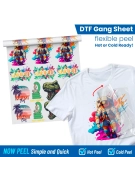DTF vs. DTG Printing

When it comes to printing designs on garments, DTF (Direct-to-Film) and DTG (Direct-to-Garment) are two prominent t-shirt printing options, each with its own unique features.
DTF uses a film to transfer designs onto various types of fabrics, offering versatility and lower costs.
On the other hand, DTG applies ink directly onto the garment, delivering high-quality and detailed prints, especially on natural fabrics.
In this comparison, we will clearly and concisely explore the key differences between these methods to help you choose the most suitable option based on your needs and goals.
DTF (Direct-to-Film)
DTF, or Direct-to-Film, is a printing technique that transfers designs to fabrics using a special film.
The process involves printing the design onto a transfer film, applying an adhesive powder over the ink, curing the adhesive powder in an conveyor oven and then transferring the cured design to the fabric using a heat press.
This method is notable for its ability to print on a wide range of materials, including polyester, cotton, and nylon, and it provides high-quality prints with vibrant colors and sharp details. It is also important to note that DTF prints can be placed on any color material, making it versatile and the perfect solution fo the majority of products.
It's especially valued for its flexibility and relatively low costs, making it suitable for large-volume productions and various applications.
Key Features:
- Print Quality: High – Offers vibrant colors and precise details.
- Durability: Designs are durable and hold up well to washing.
- Costs: Generally lower, especially for large quantities or a variety of materials.
- Compatible Materials: Versatile – Works on many types of fabrics like polyester, cotton, nylon, and fleece.
- Color Range: Wide – Allows printing a wide variety of colors, ideal for complex designs.
- Process: Prints the design onto a special film, applies adhesive powder over the ink, and transfers the design to the fabric using a heat press.
Advantages:
- Versatility: Suitable for various materials and colors.
- Cost-Efficiency: Economical for large-scale productions.
- The ability to order transfers from reputable DTF printers.
Disadvantages:
- Additional Steps: Requires multiple steps (printing, powder application, transfer) if you are printing the transfers yourself
- High costs of machinery equipment.
- Huge learning curve.
- The need to troubleshoot continuously.
DTG (Direct-to-Garment)
DTG, or Direct-to-Garment, is a printing method that applies ink directly onto the garment, similar to how an office printer prints on paper. In this process, the garment is placed in a specialized machine that sprays water-based ink directly onto the fabric. To enhance ink adhesion, a pre-treatment is applied to the garment before printing. DTG is known for providing high-quality prints with sharp details and vibrant colors, especially on natural fabrics like cotton and bamboo. This method is ideal for short runs and custom designs, delivering soft, durable results.
Key Features:
- Print Quality: High – Prints with sharp details and vibrant colors, especially on natural fabrics.
- Softness: Prints are infused with the t-shirt making the feel soft to the touch.
- Costs: Moderate: Requires a higher initial investment in equipment and pre-treatment, but is efficient for short runs.
- Compatible Materials: Limited – Mainly works on cotton and some natural blends like bamboo. Less effective on synthetic materials such as polyester.
- Color Range: Limited – Fewer color options compared to DTF, especially on dark fabrics.
- Process: Applies pre-treatment to the garment to improve ink adhesion, then prints the design directly onto the garment using a DTG printer.
Advantages:
- High Quality: Ideal for fine details and vibrant colors on natural fabrics.
- Easy Customization: Perfect for short runs and unique designs.
- Ability to print jpegs or designs with white backgrounds without using ink.
- Do not need to pre-treat white t-shirts or light garments if no white is being used in design.
Disadvantages:
- Initial Cost: Equipment and pre-treatment and ink can be expensive.
- Pre-treatment Process: The pre-treatment process can be very time-consuming and there is a learning curve to pretreating clothing.
- High room for error if the DTG pre-treatment is not covering the garment area equally with pre-treatment solution. The result in not covering the garment with an equal layer of pre-treatment will show up once the design is printed and pressed onto the shirt.
- Limited to Natural Materials: Not suitable for all types of fabric. DTG is limited to cotton based materials.
Summary of Differences between DTF vs DTG
| Aspect | DTF (Direct-to-Film) | DTG (Direct-to-Garment) |
| Print Quality | High, vibrant colors, good durability | High, especially on natural fabrics |
| Costs | Generally lower if ordering prints from a vendor | Moderate, higher initial investment for own equipment |
| Compatible Materials | Wide variety of garments (polyester, cotton, blends, nylon, spandex, denim etc.) | Mainly cotton and some natural blends. |
| Color Range | Wide, ideal for complex designs and any color garment. No garment preparation | Limited. Need pretreatment for dark colored shirts. |
| Process | Prints on film, applies adhesive powder, transfers with heat press. If ordering prints, just need to press onto shirts. | Prints directly on garment. If using dark colored cotton shirts, need to use pre-treatment per location. |
Recommended Choice for T-shirt Printing Techinique:
- Choose DTF if: You need to print on a wide range of materials, are looking for a more cost-effective option for large productions, or desire a broad color range.
- Choose DTG if: You mainly work with natural fabrics like cotton, need high-quality and detailed prints for short runs, or prefer a direct and simple printing process.
We hope this clear comparison helps you decide which printing method best fits your needs.





Leave a comment